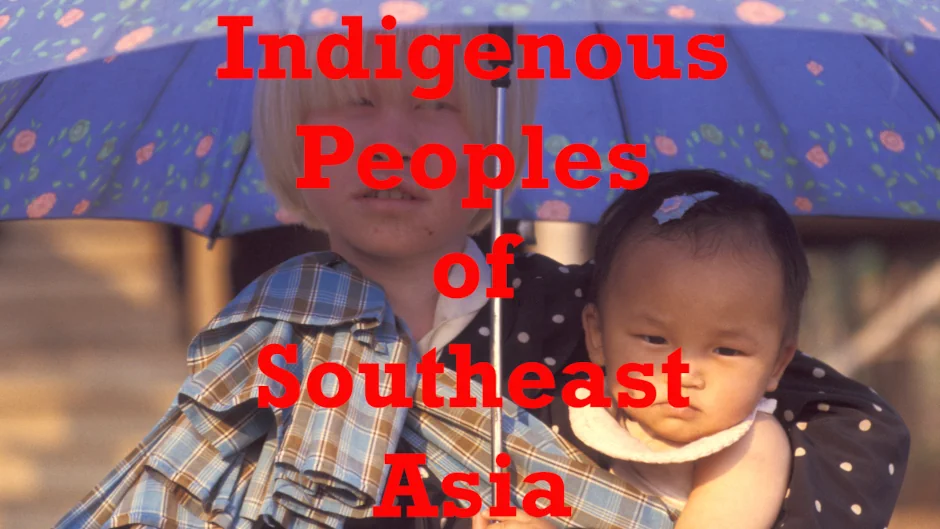The Indigenous Wa People
Ethnonyms: K'awa, Kawa, Va, Vo, Wa Pwi, Wakut Countries inhabited: Thailand, China, Burma (Myanmar) Language family: Austroasiatic Language branch: Mon-Khmer
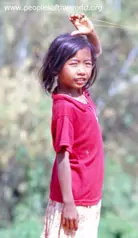
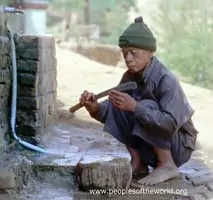 There are about one million ethnic Wa in the world; about half of them live in Burma (Myanmar), the other half live
in China. In Burma they are concentrated
in the southeastern, but mainly, and more recently, in the northeastern, parts of Shan State. Much of that area is off-limits to foreigners. While most Wa can still speak their
original language, many learn languages other
than their own — especially Burmese and Mandarin. The Summer Institute of Linguistics reports that only 1% can
read or write in their own language. This statistic places their language high on the list of the world's endangered
languages.
There are about one million ethnic Wa in the world; about half of them live in Burma (Myanmar), the other half live
in China. In Burma they are concentrated
in the southeastern, but mainly, and more recently, in the northeastern, parts of Shan State. Much of that area is off-limits to foreigners. While most Wa can still speak their
original language, many learn languages other
than their own — especially Burmese and Mandarin. The Summer Institute of Linguistics reports that only 1% can
read or write in their own language. This statistic places their language high on the list of the world's endangered
languages.
The Wa people have many things to concern themselves about such that their vanishing language is likely to be low on their
list of priorities. In 1989 the Wa formed a military wing, the United Wa State Army (UWSA), which soon negotiated a ceasefire
agreement with the Burmese military government, the Tatmadaw — just a year after the Tatmadaw had seized political control
of Burma. Since then the UWSA has allied with the Tatmadaw on many fronts.
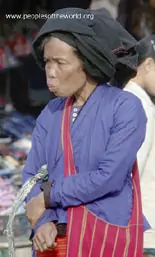 In fact their relationship is one of symbiosis.
In fact their relationship is one of symbiosis.
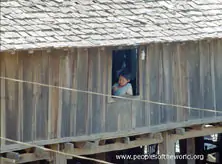 The UWSA continues to produce opium in the region and refine it into heroin.
both of which are exported to China,
Thailand and beyond. This is despite its leader, Bao You-Xiang, having claimed his intention to eradicate opium.
Profits from this lucrative trade are shared with the government and are used to help the government
maintain its power. Profits are also used to purchase military equipment and fund military operations that allow the
UWSA to support the government in its battle against ethnic
Shan independence fighters. Human Rights Watch reported in 2004 that the
UWSA forcibly enlists children. According to the Cubic Virtual Analysis Center: "Every Wa family that has two or
three sons must send at least one of them to a UWSA training camp; a family with four or five boys must send two...
some of whom were verified as young as eight years old."
The UWSA continues to produce opium in the region and refine it into heroin.
both of which are exported to China,
Thailand and beyond. This is despite its leader, Bao You-Xiang, having claimed his intention to eradicate opium.
Profits from this lucrative trade are shared with the government and are used to help the government
maintain its power. Profits are also used to purchase military equipment and fund military operations that allow the
UWSA to support the government in its battle against ethnic
Shan independence fighters. Human Rights Watch reported in 2004 that the
UWSA forcibly enlists children. According to the Cubic Virtual Analysis Center: "Every Wa family that has two or
three sons must send at least one of them to a UWSA training camp; a family with four or five boys must send two...
some of whom were verified as young as eight years old."
 In the past few years opium cultivation by the Wa has diminished. It has been replaced by production and trafficking of methamphetamine.
In the past few years opium cultivation by the Wa has diminished. It has been replaced by production and trafficking of methamphetamine.
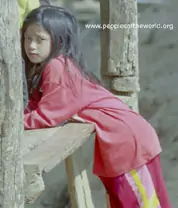 This change is partly designed to allow the government to claim that it is active in a war on drugs in the country.
Most observers believe this claim is nothing more than an exercise
in international diplomacy aimed at gaining legitimacy. The reality is that demand for the synthetic drug has become at least as high in the region as the
demand for opium and heroin.
This change is partly designed to allow the government to claim that it is active in a war on drugs in the country.
Most observers believe this claim is nothing more than an exercise
in international diplomacy aimed at gaining legitimacy. The reality is that demand for the synthetic drug has become at least as high in the region as the
demand for opium and heroin.
Before the Tatmadaw's takeover of Burma, the Wa people there had been allied with the Communist Party of Burma in the 1970s and most of the 1980s. It was this alliance that allowed them control of the region's drug trade.
Since Burma's 1949 independence, the Wa have, like many other ethnic minority peoples there,
campaigned for their people's recognition, autonomy and even independence.
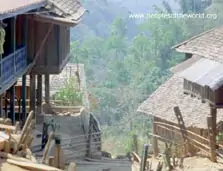
Their name translates roughly into English as "mountain dwellers."
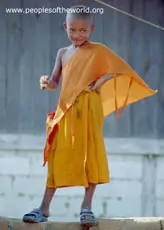 For most of their history they have lived in mountainous areas and in relative isolation from other groups.
But it has not been primarily the terrain that has kept others away; until the mid-Twentieth Century,
the Wa practiced Latou — headhunting. They also performed
human sacrifice as part of their Animist religious beliefs. While the Wa are predominantly Buddhist today (a small number
have become Christian), Animism has not completely disappeared from their beliefs and practices.
For most of their history they have lived in mountainous areas and in relative isolation from other groups.
But it has not been primarily the terrain that has kept others away; until the mid-Twentieth Century,
the Wa practiced Latou — headhunting. They also performed
human sacrifice as part of their Animist religious beliefs. While the Wa are predominantly Buddhist today (a small number
have become Christian), Animism has not completely disappeared from their beliefs and practices.
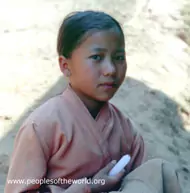 Although the Wa control much of the region's drug trade, most Wa individually have no involvement in drug trafficking.
Many grow opium poppy as a cash crop and, of course, benefit financially. But use of unrefined opium among the Wa has traditionally been medicinal, not recreational.
Recent media attention on Burma's drug economy
might suggest that this is a recent development, but populations in the region — the Wa and others —
have cultivated opium poppy for centuries.
Although the Wa control much of the region's drug trade, most Wa individually have no involvement in drug trafficking.
Many grow opium poppy as a cash crop and, of course, benefit financially. But use of unrefined opium among the Wa has traditionally been medicinal, not recreational.
Recent media attention on Burma's drug economy
might suggest that this is a recent development, but populations in the region — the Wa and others —
have cultivated opium poppy for centuries.
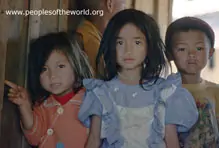 However, a cash crop that is very recent to the Wa are rubber trees
— a development aimed at helping transition the Wa away from opium poppy as a cash crop.
However, a cash crop that is very recent to the Wa are rubber trees
— a development aimed at helping transition the Wa away from opium poppy as a cash crop.
They eat a variety of subsistence crops, mainly rice, corn, potato, pineapple and banana.
The Wa also keep domestic livestock which they supplement by hunting wild animals.
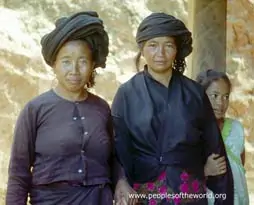 The visitor will notice that these aspects of their life have changed little over the centuries.
In contrast, the recent, mass availability of cheap products in
China — and exported to Burma from China — means that the
young generation no longer wear traditional, hand-made Wa clothing.
The visitor will notice that these aspects of their life have changed little over the centuries.
In contrast, the recent, mass availability of cheap products in
China — and exported to Burma from China — means that the
young generation no longer wear traditional, hand-made Wa clothing.
 They leave that to the older generations.
They leave that to the older generations.
The Wa have gone from relative isolation in the early part of the last century — in which human sacrifice and capture of bonded slave laborers were common — through many dramatic transitions. In the latter half of the last century, they were displaced from many parts of their historical lands by other minority groups and lowland Burmans in Burma. Writing was developed, in China, for their language only as recently as 1957. Their takeover of control of the opium trade has been accidental, not planned; and it will prove tragic for them if not diminished gradually. Today, many Wa welcome tourists into their villages and have even begun making a small income from the tourism industry as it has started to open up in Burma.
Photography copyright © 1999 - 2025, Ray Waddington. All rights reserved. Text copyright © 1999 - 2025, The Peoples of the World Foundation. All rights reserved.

Waddington, R. (2005), The Indigenous Wa People. The Peoples of the World Foundation. Retrieved December 27, 2025, from The Peoples of the World Foundation. <https://www.peoplesoftheworld.org/text?people=Wa>
Web Links China Ethnic Minority: Wa People Myanmar's Wa: Likely losers in the opium war Wa Dictionary Project Books Fiskesjö, M., (2000) The Fate of Sacrifice and the Making of Wa History. Unpublished Ph.D. Dissertation. University of Chicago (UMI Number 9959092). Available digitally at The University of Hong Kong Libraries.
